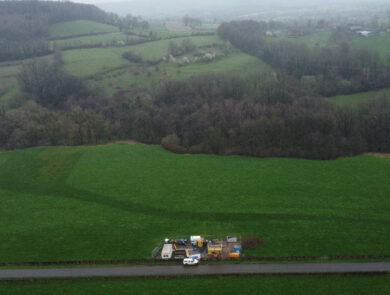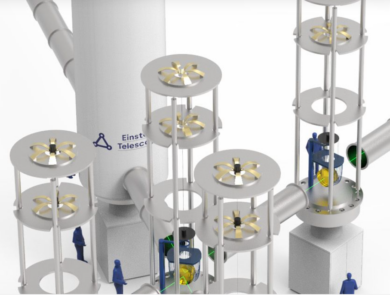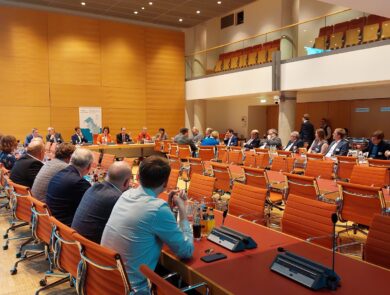Einstein Telescope as unifying example at teachers’ day
How do you inspire secondary school teachers to bring state-of-the-art physics into the classroom? During the Physics Teachers’ Day at Eindhoven University of Technology, researcher Gideon Koekoek shows how diverse areas of physics come together in the theory behind the Einstein Telescope.
“Welcome to an afternoon about cutting edge physics.” Speaking to an auditorium full of physics teachers is Gerrit Kroesen, a professor of physics at Eindhoven University of Technology (NL). There, Kroesen leads an extensive programme to improve the connection between secondary schools and further education. On 26 March, that means a special afternoon for 50 secondary school physics teachers. They will gain inspiration during workshops, laboratory visits and lectures on the most exciting modern research.

Light
The theme of the teachers’ day is light, from applications like computer chips using light instead of electricity, to etching minute transistors, or taking pictures of a black hole. In his keynote lecture, gravity wave researcher Gideon Koekoek (Maastricht University and Nikhef) explains how deeply light is intertwined with other parts of physics. The trigger: a critical student.
Koekoek: “Our teaching methods present physics as free-standing subfields, each for its own subject. Instead, I wanted to show the deep connections that make all these rules form a coherent whole. That is the real power of physics.”
Kritische leerling
Top level secondary school students already get a taste of Einstein’s theory of relativity in the classroom. A theory full of brain teasers, such as clocks that slow down and lineals that shrink as they pass at a speed close to that of light: 299,792,458 metres per second.
The extended version of the theory of relativity states that gravity too is nothing but a distortion of spacetime. Bring enough force to bear, such as during a collision between black holes, and spacetime can even ripple with waves that head out into the universe. Exactly the phenomenon that Koekoek wants to investigate with the Einstein Telescope and about which he talks at the Einstein Telescope Education Centre (ETEC) in Kerkrade (NL). But how do you explain the theory of relativity to high school students in the first place?
“I spent a few years in front of the classroom myself,” Koekoek tells his colleagues. “But when I gave my class the standard introduction to relativity theory, one student countered. ‘Why does the speed of light have such a central role in the theory of relativity? And why do the formulas also apply to phenomena that do not involve light?’ Frankly that student was right; your proof has to be solid. So I set out to make that link clear. Want to follow along?”
What follows is a lightning-fast lecture. Using props such as balloons and stuffed animals, Koekoek proves that the theory of relativity does not fall from the sky, but is already hidden in Newton’s theory of motion. Even the central role of the speed of light, which Einstein included in his theory as an assumption, can be deduced from other natural laws with a bit of calculation: “From the formulas you see that the universe must have a maximum speed. And you can prove that with high school mathematics! I’ll share my work so you prove this yourself with your students.”

One example
Too spicy for the classroom? On the contrary – participants to the teachers’ day seemed inspired. They are left with examples from the lectures and laboratory visits that they can use in class to explain what you can do with physics later on. As the chair of the event, Gerrit Kroesen is also satisfied: “This talk was challenging, but also was a beautiful demonstration of the coherence of physics. That’s what you can convey to the next generation.”
“We’ve all known that one teacher who made the difference,” says Kroesen: “that’s also how I got here myself. If every participant in this teachers’ day takes home just one example of modern physics that they can use in the classroom to inspire their students, I am very satisfied.”
Education centre
For those interested in learning more about the theory of relativity, gravitational waves and the Einstein Telescope, there is good news. With the help of Gideon Koekoek, the Discovery Museum in Kerkrade (NL) is developing the new Einstein Telescope Education Centre (ETEC), with teaching materials for secondary schools. The doors will open after the summer of 2024.


